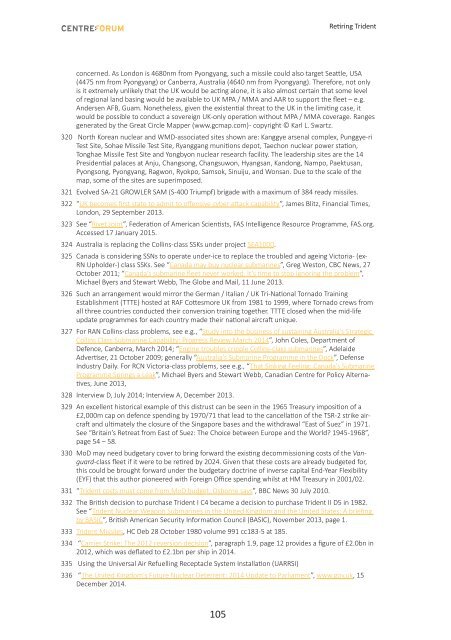Retiring Trident
retiring-trident
retiring-trident
You also want an ePaper? Increase the reach of your titles
YUMPU automatically turns print PDFs into web optimized ePapers that Google loves.
<strong>Retiring</strong> <strong>Trident</strong><br />
concerned. As London is 4680nm from Pyongyang, such a missile could also target Seattle, USA<br />
(4475 nm from Pyongyang) or Canberra, Australia (4640 nm from Pyongyang). Therefore, not only<br />
is it extremely unlikely that the UK would be acting alone, it is also almost certain that some level<br />
of regional land basing would be available to UK MPA / MMA and AAR to support the fleet – e.g.<br />
Andersen AFB, Guam. Nonetheless, given the existential threat to the UK in the limiting case, it<br />
would be possible to conduct a sovereign UK-only operation without MPA / MMA coverage. Ranges<br />
generated by the Great Circle Mapper (www.gcmap.com) - copyright © Karl L. Swartz.<br />
320 North Korean nuclear and WMD-associated sites shown are: Kanggye arsenal complex, Punggye-ri<br />
Test Site, Sohae Missile Test Site, Ryanggang munitions depot, Taechon nuclear power station,<br />
Tonghae Missile Test Site and Yongbyon nuclear research facility. The leadership sites are the 14<br />
Presidential palaces at Anju, Changsong, Changsuwon, Hyangsan, Kandong, Nampo, Paektusan,<br />
Pyongsong, Pyongyang, Ragwon, Ryokpo, Samsok, Sinuiju, and Wonsan. Due to the scale of the<br />
map, some of the sites are superimposed.<br />
321 Evolved SA-21 GROWLER SAM (S-400 Triumpf) brigade with a maximum of 384 ready missiles.<br />
322 “UK becomes first state to admit to offensive cyber attack capability”, James Blitz, Financial Times,<br />
London, 29 September 2013.<br />
323 See “Rivet Joint”, Federation of American Scientists, FAS Intelligence Resource Programme, FAS.org.<br />
Accessed 17 January 2015.<br />
324 Australia is replacing the Collins-class SSKs under project SEA1000.<br />
325 Canada is considering SSNs to operate under-ice to replace the troubled and ageing Victoria- (ex-<br />
RN Upholder-) class SSKs. See “Canada may buy nuclear submarines”, Greg Weston, CBC News, 27<br />
October 2011; “Canada’s submarine fleet never worked. It’s time to stop ignoring the problem”,<br />
Michael Byers and Stewart Webb, The Globe and Mail, 11 June 2013.<br />
326 Such an arrangement would mirror the German / Italian / UK Tri-National Tornado Training<br />
Establishment (TTTE) hosted at RAF Cottesmore UK from 1981 to 1999, where Tornado crews from<br />
all three countries conducted their conversion training together. TTTE closed when the mid-life<br />
update programmes for each country made their national aircraft unique.<br />
327 For RAN Collins-class problems, see e.g., “Study into the business of sustaining Australia’s Strategic<br />
Collins Class Submarine Capability: Progress Review March 2014”, John Coles, Department of<br />
Defence, Canberra, March 2014; “Engine troubles cripple Collins-class submarines”, Adelaide<br />
Advertiser, 21 October 2009; generally “Australia’s Submarine Programme in the Dock”, Defense<br />
Industry Daily. For RCN Victoria-class problems, see e.g., “That Sinking Feeling: Canada’s Submarine<br />
Programme Springs a Leak”, Michael Byers and Stewart Webb, Canadian Centre for Policy Alternatives,<br />
June 2013,<br />
328 Interview D, July 2014; Interview A, December 2013.<br />
329 An excellent historical example of this distrust can be seen in the 1965 Treasury imposition of a<br />
£2,000m cap on defence spending by 1970/71 that lead to the cancellation of the TSR-2 strike aircraft<br />
and ultimately the closure of the Singapore bases and the withdrawal “East of Suez” in 1971.<br />
See “Britain’s Retreat from East of Suez: The Choice between Europe and the World? 1945-1968”,<br />
page 54 – 58.<br />
330 MoD may need budgetary cover to bring forward the existing decommissioning costs of the Vanguard-class<br />
fleet if it were to be retired by 2024. Given that these costs are already budgeted for,<br />
this could be brought forward under the budgetary doctrine of inverse capital End-Year Flexibility<br />
(EYF) that this author pioneered with Foreign Office spending whilst at HM Treasury in 2001/02.<br />
331 “<strong>Trident</strong> costs must come from MoD budget, Osborne says”, BBC News 30 July 2010.<br />
332 The British decision to purchase <strong>Trident</strong> I C4 became a decision to purchase <strong>Trident</strong> II D5 in 1982.<br />
See “<strong>Trident</strong> Nuclear Weapon Submarines in the United Kingdom and the United States: A briefing<br />
by BASIC”, British American Security Information Council (BASIC), November 2013, page 1.<br />
333 <strong>Trident</strong> Missiles, HC Deb 28 October 1980 volume 991 cc183-5 at 185.<br />
334 “Carrier Strike: The 2012 reversion decision”, paragraph 1.9, page 12 provides a figure of £2.0bn in<br />
2012, which was deflated to £2.1bn per ship in 2014.<br />
335 Using the Universal Air Refuelling Receptacle System Installation (UARRSI)<br />
336 “The United Kingdom’s Future Nuclear Deterrent: 2014 Update to Parliament”, www.gov.uk, 15<br />
December 2014.<br />
105




